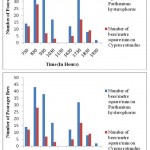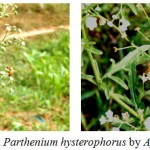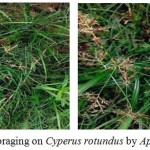How to Cite | Publication History | PlumX Article Matrix
Indu Kumari and Rajesh Kumar
Department of Bioscience, School of Basic Science Arni University, Kangra (H.P.) 176401.
Corresponding Author E-mail: indu7553@gmail.com
DOI : http://dx.doi.org/10.13005/bbra/2558
ABSTRACT: Honeybees are the small wonderful creatures which depend upon flowers for their food. Worker bees always keep on collecting food (pollen & nectar) and store it inside the comb. They later transform pollen into bee bread and nectar into honey with the help of enzymatic activity. Both bee bread and honey are used as reserve food material by bees during harsh weather to maintain their population which otherwise gets affected due to non-availability of flowers. The situation becomes more severe if dearth period run for longer time as the food stores inside the colony gets depleted. At this time, bees start collecting pollen from wild flowers/weeds available in the vicinity of apiary. During summer/monsoon dearth period, many weeds and herbs germinate in the wasteland or crop fields. Parthenium hysterophorus and Cyperus rotundus are two important weeds which are in full bloom during this period. Although, both these weeds are not considered good for the environment especially Parthenium causes various ill effects to human health, honeybees forage upon these weeds with great interest. In the present study, foraging activity of Apis mellifera was observed on both the weeds.
KEYWORDS: Apis Mellifera Foraging; Weed; Wasteland;
Download this article as:| Copy the following to cite this article: Kumari I, Kumar R. Parthenium Hysterophorus and Cyperus Rotundus: Alternative Sources of food for Honeybees During Dearth Period. Biosci Biotech Res Asia 2017;14(3). |
| Copy the following to cite this URL: Kumari I, Kumar R. Parthenium Hysterophorus and Cyperus Rotundus: Alternative Sources of food for Honeybees During Dearth Period. Biosci Biotech Res Asia 2017;14(3). Available from: https://www.biotech-asia.org/?p=27474 |
Introduction
Honeybees forage upon flowers all around the year and obtain their nutrition from pollen (protein) and nectar (carbohydrates). But flowers are not available all round the year. In the summer and rainy season, there is scarcity of flowers and bees are not able to forage upon the flowers. They have to sustain with the available food stores. This floral scarcity period is often called dearth period. Sufficient knowledge of bee flora is the necessity for establishing an apiary in any location. Floral knowledge is the basic requirement which directly affects the colony performance and production of honey. Due to the lack of basic knowledge about bee flora, beekeepers many times face a lot of problems. The knowledge of bee flora/foraging helps the beekeepers to have an idea on abundance of pollen and nectar sources as well as, it also helps in timely management of bee colonies during lean periods in particular and round the year in general. One of the prime issues faced by beekeepers is the floral dearth period. Pollen stimulative diets, cereal based pollen substitute, sugar syrup and fruit based syrup are given to honeybees during harsh/dearth period of the year (Mishra 1995; Pande et al., 2011, Sihag and Gupta, 2013; Kumar et al., 2013; Pande and karnatak, 2013; Kumar and Agrawal, 2014; Pande and karnatak, 2014; Pande et al., 2015; Renzi et al., 2016; Omar et al., 2017). Some of the minor floral sources prove to be boon for honeybees in unfavourable period of the year for strengthening the bee colonies. During summer & monsoon season, a lot of weeds/herbs appear in the wasteland/crop fields/barren land. Two of such weeds are Parthenium hysterophorus and Cyperus rotundus which are found in abundance in North India. Parthenium hysterophorus is a type of weed which belongs to the family Asteraceae and order Asterales. It is one of the fast growing, branched, annual or ephemeral herb. The stem of Parthenium is hairy and leaves are simple and pinnately/bipinnately dissected. Flowers appear in the monsoon season, flowers are creamy white in color. Parthenium grows in wild/natural conditions without any special sowing. It mainly inhabits wastelands, forestlands, agricultural areas, roadsides and residential plots (Kaur et al., 2014). Cyperus rotundus belongs to family Cyperaceae and order Poales, is a perennial weed grows in tropical, subtropical and temperate region. This weed is also known as nutsedge/nutgrass. It contains bulbous rhizomes, tubers, narrow shaped leaves and flowers with red brown husk (Sivapalan, 2013 & Das et al., 2015). It cultivates naturally most commonly near paddy crop field, wasteland with green vegetation of moistened condition in northern region of India. Apis mellifera forages frequently on this weed in the absence of major bee flora.
Detailed knowledge of these weeds as bee flora is very diminutive in various areas of beekeeping. Taking into considerations the importance of minor bee flora and role of weeds/herbs as a source of pollen, the present study was carried out in Indora region of district Kangra, Himachal Pradesh (India).
Materials and Methods
The present study was conducted in Arni University Campus, Kangra (HP) situated on longitude 75° 10‘ E and latitude 32° 29’N, elevation from mean sea level is approx 450 meters. Plot with highly dense Parthenium hysterophorous and Cyperus rotundus were selected near the apiary of Apis mellifera. Abundance of bees was observed by counting the number of honeybees per square metre per minute. Study was conducted during pre-monsoon period i.e. May to July, 2017. Observations were taken after every one hour for five minutes with the help of stop watch, starting from 730 to 1930 hours on every alternate day for 60 days. Data collected was consolidated and analyzed using sigma plot software.
Results
Foraging activity of Apis mellifera was recorded for both Parthenium hysterophorus & Cyperus rotundus (Fig. 1). It was observed that during May to July 2017, when sufficient flora was not available, bees foraged upon both these weeds with great interest (Photograph 1 and 2). The foraging activity by bees on weeds during summer dearth period under Punjab conditions has already been confirmed (Dalio, 2008; Dalio, 2013). Maximum bee foraging on Parthenium hysterophorus was noticed during morning hours. Maximum number of foraging bees 43±2.05 bees/ m²/ min were reported at 830 hours. The number of forager bees decreased to 38±1.7 and 17±2.15 at 930 & 1030 hours respectively. No activity was noticed during noon hours, reason behind this may be high temperature as it is well known fact that at extremely high temperature, foraging activity ceases. Forager bees again started their activity after 1600 hours. At 1630 hours, 12±1.8 bees/ m²/ min were recorded on Parthenium flowers which increased to 32±2.10 at 1730 hours. Abundance of foraging bees was reduced to 8 bees/m²/min at 1830 hours which further decreased and found minimum (2±0.8 bees/m²/ min) at 1930 hours. Similarly, foraging activity of bees was recorded on Cyperus rotundus (Fig 1). Number of forager bees per unit area per minute was found maximum at 830 hours (28±1.3) followed 12±0.8, 7±1.2 and 3±0.9 bees/m²/min at 730, 930 & 1030 hours respectively. No forager bee was observed at 1130 hours. Bees were reported foraging upon Cyperus rotundus again after 1600 hours values being 5±1.8, 17±2.1, 9±1.03 bees/m²/min at 1630, 1730 and 1830 hours respectively. No bee activity was observed at 1930 hours.
 |
Figure 1: Number of Forager at Different Day Hours
|
 |
Graph 1: Foraging on Parthenium hysterophorus by Apis mellifera
|
 |
Graph 2: Foraging on Cyperus rotundus by Apis mellifera
|
Discussion
Honeybees collect pollen from both Parthenium hysterophorus and Cyperus rotundus during lean periods when enough bee flora is not available. It was observed during the study that maximum foraging took place during morning hours and late evening hours. Similar types of observations have been confirmed by many workers on various weeds/crops (Abrol, 1997; Thakur et al., 1982; Dalio, 2012). In the current study, peak foraging time was observed at 830 hours. The results are concurrent to the study carried out by Dalio 2013 who reported morning hours as best bee foraging time on Parthenium hysterophorus in Punjab conditions. No activity was reported during day hours. Factors responsible for slow activity of bees during day/noon hours might be high temperature during May to July months, instinctive foraging behaviour of bees; floral structure, environmental factors, type and density of flowers also contribute towards foraging (Kuhn and Ambrose, 1982; Rao and Suryanarayana, 1990; Dalio, 2008).
Conclusion
It may be concluded at the end of study that Parthenium hysterophorus and Cyperus rotundus are the alternative sources of flora during the pollen dearth period (June to July). Both these weeds are found in abundance in study area. For successful beekeeping, it is important to study the availability of such weeds which provide pollen during floral scarce period. Both these weeds are considered nastiest for human beings, as they may cause skin ailments and many other allergic problems but as the bees obtain some amount of pollen from these weeds so they play an important role in the management of apiaries during pollen dearth periods.
Acknowledgement
Authors are highly thankful to Himachal Pradesh Council for Science, Technology and Environment (HIMCOSTE), Shimla (H.P.) for providing research grant under research project for carrying out this work.
Conflict of Interest
There is no any conflict of interest of any author including any financial, personal or other relationships with other people or organizations that can influence their work.
References
- Mishra R. C. Social behaviour of bees and related management practices, In: Honeybees and their management in India. Krishi Anusandhan Bhawan, Pusa, New Delhi. 1995;44-59.
- Pande R., Firake D. M and Karnatak A. K. Development of pollen substitutes for dearth period management of honeybee (Apis mellifera) colonies in foothills of Shivalik range of Himalayas. Indian J. of Agric. Sci. 2011;81(9): 861–866.
- Sihag R. C And Gupta M. Testing the effect of some pollen substitute on colony build up and economics of beekeeping with Apis mellifera L. J. Ent. 2013;10(3):120-135.
- Kumar R., Mishra R. C and Agrawal O.P. Effect of feeding artificial diets to honey bees during dearth period under Panchkula (Haryana) conditions. J. Ent. Res. 2013;37(1):41-45.
- Pande R and Karnatak A. K. Utilization of temperate fruits for off-season dietary management of honey bees. Indian J. of Horti. 2013;70(3):345-349.
- Kumar R and Agrawal O. P. Comparative performance of honeybee colonies fed with artificial diets in Gwalior & Panchkula region. J. Ent. Zoo. Studies. 2014;2(4):104-107.
- Pande R and Karnatak A. K. Germinated pulses as a pollen substitute for dearth period management of honey bee colonies. Current Biotica. 2014;8(2):142-150.
- Pande R., Karnatak A. K and Pandey N. Development of nectar supplement for dearth period management of honey bees (Apis mellifera Linnaeus) colonies in foothills of Shivalik range of Himalayas. The bioscan. 2015;10(4):1599-1603.
- Renzi M. T., Rodriguez-Gasol N., Medrzycki P., Porrini C., Martini A., Burgio G., Maini S and Sgolastra F. Combined effect of pollen quality and thiamethoxam on hypopharyngeal gland development and protein content in Apis mellifera. Apidologie. 2016. Retrived from: Google Scholar. DOI: 10.1007/s13592-016-0435-9.
CrossRef - Omar E., Abd- Ella., Aly A., Khodairy M. M., Moosbeckhofer R., Crailsheim K And Brodschneider R. Influence of different pollen diets on the development of hypopharyngeal glands and size of acid gland sacs in caged honey bees (Apis mellifera). Apidologie. 2017;48(4):425-436.
CrossRef - Kaur M., Aggarwal N. K., Kumar V and Dhiman R. Effect and management of Parthenium hysterophorus: A weed of global significance. Int Scholar Res Notices. 2014. Available from: http://dx.doi.org/10.1155/2014/368647.
CrossRef - Sivapalan S. R. Medicinal uses and pharmacological activities of Cyperus rotundus Linn- A Review. Int. J. Sci. Res. Pub. 2013;3(5):1-8.
- Das B., Pal D and Haldar A. A review on Cyperus rotundus as a tremendous source of pharmacologically active herbal medicine. Int. J. Green Pharma. 2015; 9(4): 198-203.
- Dalio J. S. Foraging behaviour of Apis mellifera on Cyperus rotundus L. J. Ent. Res. 2008;32(4):335-337.
- Dalio J. S. Foraging activity of Apis mellifera on Parthenium hysterophorus. IOSR J Pharma Bio. Sci. 2013;7(5): 01-04.
- Abrol D. P. Bees and beekeeping in India. Kalyani publishers Ludhiana, 1st edn. India. 1997;110-130.
- Thakur A. K., Sharma O. P., Garg R and Dogra G. S. comparative study on foraging behaviour of Apis mellifera and A. cerana indica on mustard. Indian Bee J. 1982;44(4):91-92.
- Dalio J. S. Cannabis sativa- An important subsistence pollen source for Apis mellifera IOSR J. Pharma. Bio. Sci. 2012;32(4):335-337.
- Kuhn E. D and Ambrose J. T. Foraging behaviour of honeybees on Golden Delicious and Delicious apple. J. Amer. Soc. Hort. Sci. 1982;107(3):391-395.
- Rao G. M and Suryanarayana M. C. Studies on foraging behaviour of honeybees and its effect on the seed yield in Niger. Indian Bee J. 1990;52(4):31-33.

This work is licensed under a Creative Commons Attribution 4.0 International License.





